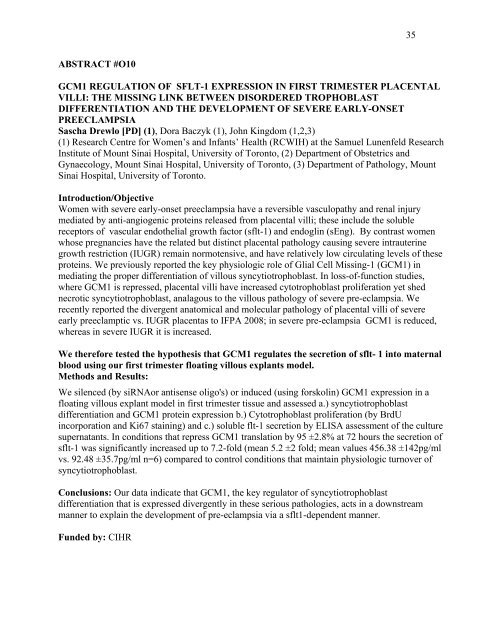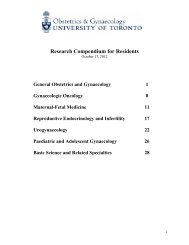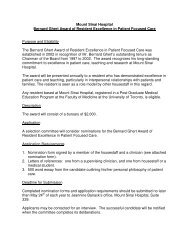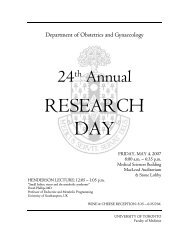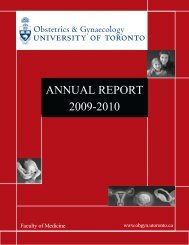research day - University of Toronto Department of Obstetrics and ...
research day - University of Toronto Department of Obstetrics and ...
research day - University of Toronto Department of Obstetrics and ...
Create successful ePaper yourself
Turn your PDF publications into a flip-book with our unique Google optimized e-Paper software.
35<br />
ABSTRACT #O10<br />
GCM1 REGULATION OF SFLT-1 EXPRESSION IN FIRST TRIMESTER PLACENTAL<br />
VILLI: THE MISSING LINK BETWEEN DISORDERED TROPHOBLAST<br />
DIFFERENTIATION AND THE DEVELOPMENT OF SEVERE EARLY-ONSET<br />
PREECLAMPSIA<br />
Sascha Drewlo [PD] (1), Dora Baczyk (1), John Kingdom (1,2,3)<br />
(1) Research Centre for Women’s <strong>and</strong> Infants’ Health (RCWIH) at the Samuel Lunenfeld Research<br />
Institute <strong>of</strong> Mount Sinai Hospital, <strong>University</strong> <strong>of</strong> <strong>Toronto</strong>, (2) <strong>Department</strong> <strong>of</strong> <strong>Obstetrics</strong> <strong>and</strong><br />
Gynaecology, Mount Sinai Hospital, <strong>University</strong> <strong>of</strong> <strong>Toronto</strong>, (3) <strong>Department</strong> <strong>of</strong> Pathology, Mount<br />
Sinai Hospital, <strong>University</strong> <strong>of</strong> <strong>Toronto</strong>.<br />
Introduction/Objective<br />
Women with severe early-onset preeclampsia have a reversible vasculopathy <strong>and</strong> renal injury<br />
mediated by anti-angiogenic proteins released from placental villi; these include the soluble<br />
receptors <strong>of</strong> vascular endothelial growth factor (sflt-1) <strong>and</strong> endoglin (sEng). By contrast women<br />
whose pregnancies have the related but distinct placental pathology causing severe intrauterine<br />
growth restriction (IUGR) remain normotensive, <strong>and</strong> have relatively low circulating levels <strong>of</strong> these<br />
proteins. We previously reported the key physiologic role <strong>of</strong> Glial Cell Missing-1 (GCM1) in<br />
mediating the proper differentiation <strong>of</strong> villous syncytiotrophoblast. In loss-<strong>of</strong>-function studies,<br />
where GCM1 is repressed, placental villi have increased cytotrophoblast proliferation yet shed<br />
necrotic syncytiotrophoblast, analagous to the villous pathology <strong>of</strong> severe pre-eclampsia. We<br />
recently reported the divergent anatomical <strong>and</strong> molecular pathology <strong>of</strong> placental villi <strong>of</strong> severe<br />
early preeclamptic vs. IUGR placentas to IFPA 2008; in severe pre-eclampsia GCM1 is reduced,<br />
whereas in severe IUGR it is increased.<br />
We therefore tested the hypothesis that GCM1 regulates the secretion <strong>of</strong> sflt- 1 into maternal<br />
blood using our first trimester floating villous explants model.<br />
Methods <strong>and</strong> Results:<br />
We silenced (by siRNAor antisense oligo's) or induced (using forskolin) GCM1 expression in a<br />
floating villous explant model in first trimester tissue <strong>and</strong> assessed a.) syncytiotrophoblast<br />
differentiation <strong>and</strong> GCM1 protein expression b.) Cytotrophoblast proliferation (by BrdU<br />
incorporation <strong>and</strong> Ki67 staining) <strong>and</strong> c.) soluble flt-1 secretion by ELISA assessment <strong>of</strong> the culture<br />
supernatants. In conditions that repress GCM1 translation by 95 ±2.8% at 72 hours the secretion <strong>of</strong><br />
sflt-1 was significantly increased up to 7.2-fold (mean 5.2 ±2 fold; mean values 456.38 ±142pg/ml<br />
vs. 92.48 ±35.7pg/ml n=6) compared to control conditions that maintain physiologic turnover <strong>of</strong><br />
syncytiotrophoblast.<br />
Conclusions: Our data indicate that GCM1, the key regulator <strong>of</strong> syncytiotrophoblast<br />
differentiation that is expressed divergently in these serious pathologies, acts in a downstream<br />
manner to explain the development <strong>of</strong> pre-eclampsia via a sflt1-dependent manner.<br />
Funded by: CIHR


